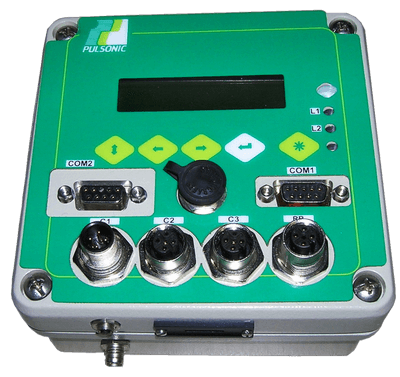
Data loggers evolved to replace chart recorders, which used electrical impulses to flex appendages tipped with pens, like the stylus of a record player, which traced lines on reels of paper tape.
The deviations of the traced ink lines from center created a visual representation of changes in conditions like temperature or pressure.
Chart recorders were phased out to make room for data loggers, a more compact, accurate, and cost-effective way to record environmental data.
What Is a Data Logger?
In addition to the sensors, data loggers usually include a microprocessor, which interprets the environmental input from the sensors, and a digital storage device like a hard drive or flash drive that records—or “logs”—the data that the microprocessor produces.
Some data loggers need to be hard-plugged into a computer to extract the data; others can transmit data over wireless networks.
What Are the Different Types of Data Loggers?
What kind of data are we talking about? Data loggers can be created to record almost anything that can be digitally measured, including:
- Temperature. Temperature data loggers record the ambient temperature of an environment, alerting users to sudden changes in temperature that may cause product damage or unsafe conditions.
- Resistant Temperature Detection (RTD). An RTD data logger is a fragile but highly-accurate form of temperature data logger that judges the ambient temperature due to the speed of electrons as they pass through a length of copper, nickel, or platinum wire wrapped around a glass or ceramic core. They are appropriate for environments that need very accurate temperature records.
- Humidity. Warehouses, greenhouses, calibration rooms, and other spaces may require a certain amount of moisture in the atmosphere to remain functional or safe. Data loggers can be used to record humidity over time within the environment.
- Pressure. Barometric data loggers can be used to record the pressure of gases or liquids in an environment. This can be crucial to determine water levels, fluid, or gas flow, speed, or altitude, as well as to record weather events. Many pressure data loggers are built to withstand intense conditions, like harsh weather, high heat, or submergence in deep water.
- Absolute Pressure. A subset of pressure data loggers, these devices can determine the load or strain a structure like a building or bridge is subjected to.
- Vibration. Data loggers can create a record of vibrations and shocks over time. Some with built-in accelerometers can record tri-axial shock. These can be used to detect impact or measure the shock threshold of a breach.
- Current. Data loggers can keep a record of electrical current passing through a system, which can be critical in diagnosing insufficient current, as well as detecting dangerously high current.
- Voltage. Voltage data loggers are a variation on current data loggers that record voltage, an expression of current multiplied by resistance.
How Do I Know If I Need A Data Logger?
Many industries need to monitor environmental conditions and keep a log of ambient data to function properly and safely. Industries that benefit from digital data loggers include:
Healthcare
Hospitals, medical research institutions, and their associated equipment have to work properly. Human lives are at stake if they malfunction.
Data loggers can be used to monitor temperature, air pressure, and humidity with an eye toward patient safety. Temperature logging may be required to maintain the integrity of biological materials and medications that require cold storage or cryogenic freezing.
Data loggers can also monitor current and voltage to ensure that lifesaving equipment remains functional.
Food
Food products are very sensitive to environmental conditions. Data loggers may be critical to verify the safe transport and handling of food products, including the temperature of trucks, warehouses, and processing facilities the food passes through.
Without careful monitoring of the food’s environment, contaminants could flourish and the food could cause a public health crisis.
Aerospace
Manufacturers and operators of airplanes, helicopters, and missiles must keep careful track of the temperatures, gas pressures, fluid pressures, and shocks that the machinery is subjected to.
Manufacturing
Factories contain a variety of environmental factors that play a key role in the successful manufacturing of high-quality products. A short list includes:
- The air temperature, pressure, and humidity of the factory.
- The temperature and pressure to which materials are subjected.
- Fluid and gas pressures within tanks and engines.
- Current and voltage passing through electronic machinery.
Agriculture
Environmental conditions matter a great deal to successful agriculture. Data loggers can provide agricultural producers with an actionable record of conditions like air pressure, temperature, and moisture, as well as soil moisture, groundwater levels, and shock records, to detect conditions that could endanger a crop, herd, or harvest.
Environmental Research
Data loggers play a key role in understanding the natural world, measuring temperatures, pressures, moisture levels, groundwater levels, and shock levels that influence climate, ecosystems, and geological events like earthquakes and volcanic activity.
How Do I Use A Data Logger Effectively?
Proper use of a data logger includes:
- Selection. Choosing the right data logger or loggers for the conditions you need to monitor, including the requisite capacity. A voltage data logger is useless if its circuitry and microprocessor can’t handle the voltage your machinery is rated for, or if your recording intervals are so short and the recording drive so small that you run out of storage in a day.
- Installation. The data logger must be properly installed according to manufacturer specifications, in a manner and position that won’t impede either your operations or the function of the data logger.
- Monitoring. Establish a schedule for review and processing of the data that the logger records. Make sure you understand the process by which the data can safely be accessed, either by hardwire interface or wireless signal.
- Purging. Establish a schedule by which the data will be archived and purged from the local storage drive.
Conclusion
Data loggers are powerful tools in the safe and effective operation of enterprises in many critical industries.